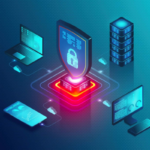In today’s digital age, it’s more important than ever to keep your online presence safe and secure. With the rise of cyber attacks and data breaches, protecting yourself from online security threats should be a top priority. Fortunately, there is a secret code you can use to fortify your defenses against these dangers. In this blog post, we’ll reveal the /xmbv0rh7_kk secret code that can help you stay safe and secure while browsing the internet. Read on to learn how to use this powerful tool and protect yourself against cyber criminals!
What is the Secret Code?
The /xmbv0rh7_kk secret code is a unique and powerful tool that can help protect you from online security threats. It is essentially a randomly generated string of characters that you can use as your password or passphrase when creating accounts on websites or applications.
Using the /xmbv0rh7_kk secret code ensures that your password cannot be easily guessed by hackers, and it also makes it harder for them to crack through brute force attacks. This code is generated using complex algorithms, resulting in a combination of letters, numbers, and symbols that are difficult to replicate.
It’s important to note that while the /xmbv0rh7_kk secret code offers increased protection against cybersecurity threats, it should not be used as the sole method of securing your online presence. You should still take other precautions such as enabling two-factor authentication whenever possible and avoiding suspicious links or downloads.
Incorporating the /xmbv0rh7_kk secret code into your online routine can provide an additional layer of security for your personal information and digital assets.
How to Use the Secret Code
The Secret Code is an innovative tool that can be used to enhance your online security. But how do you use it? It’s actually quite simple.
First, choose a unique code that only you know and won’t easily guess. This could be a combination of letters, numbers, and symbols.
Next, use this code as your password for all important accounts such as email, banking or social media platforms. Make sure to change the passwords regularly to avoid potential hacking attempts.
You can also use the secret code in conjunction with two-factor authentication for even stronger protection. This means that after entering your password, you will receive a second verification code sent to your phone or email before gaining access to your account.
Remember not to share your Secret Code with anyone else and keep it safe from prying eyes by storing it in a secure location offline or using reliable password management software.
By following these steps and utilizing the Secret Code effectively, you’ll increase your chances of staying protected against cyber threats online.
The Rise of Cybersecurity Threats
In recent years, cybersecurity has become an increasingly important issue in the tech world. With more and more people relying on technology for their daily activities, hackers have found new ways to exploit vulnerabilities in online systems.
The rise of cyber threats has been fueled by a number of factors. One key factor is the increasing use of mobile devices and cloud computing services. These technologies have made it easier for users to access data from anywhere, but they’ve also created new security risks that need to be addressed.
Another contributing factor is the growing sophistication of cyber attackers. Hackers are constantly developing new methods for breaching security systems and stealing sensitive information. They often use social engineering tactics to trick users into giving up their passwords or other confidential data.
As a result, it’s more important than ever for individuals and organizations to take steps to protect themselves against cyber threats. This includes using strong passwords, regularly updating software, backing up data, and being vigilant about suspicious activity.
Ultimately, we must all remain aware of the evolving nature of these attacks and stay informed about best practices for safeguarding our digital lives.
The Different Types of Online Security Threats
Online security threats are becoming increasingly prevalent, with cybercriminals constantly finding new ways to exploit vulnerabilities in our digital lives. One of the most common types of online security threats is phishing attacks. These attacks involve tricking users into providing sensitive information such as passwords, credit card numbers or login credentials by posing as a trustworthy entity.
Another type of online threat is malware, which refers to software that is designed to harm your computer or steal your data. Malware can come in many forms including viruses, worms and trojan horses. It’s important to always have anti-virus software installed on your devices and keep it up-to-date.
Ransomware is another type of cybercrime that has become more prevalent in recent years. This involves hackers gaining access to a user’s system and encrypting their files until they pay a ransom fee for the decryption key.
Social engineering attacks are also on the rise, where attackers manipulate people into divulging confidential information through psychological tactics rather than exploiting technical vulnerabilities.
There are Distributed Denial-of-Service (DDoS) attacks which flood websites with traffic making them unavailable for legitimate users. These types of attacks can be difficult to prevent since they often involve coordinated efforts from multiple sources.
It’s crucial for individuals and organizations alike to remain vigilant against these various types of online security threats by implementing proper precautions such as keeping software up-to-date, using strong passwords and being cautious when opening emails or clicking links from unknown sources.
How to Protect Yourself Against Cybersecurity Threats
In today’s digital age, protecting yourself against cybersecurity threats is more important than ever. Here are some tips to help keep your personal information safe:
1. Use strong passwords: Make sure your passwords are unique and complex, including a combination of upper and lowercase letters, numbers and symbols.
2. Keep software up to date: Regularly update all the software on your devices (including antivirus programs) to minimize vulnerabilities that could be exploited by hackers.
3. Be cautious online: Avoid clicking on suspicious links or downloading attachments from unknown sources.
4. Use two-factor authentication: This adds an extra layer of security by requiring a second form of verification before granting access to accounts or devices.
5. Encrypt sensitive data: Encryption helps protect your sensitive information when it’s transmitted over the internet, making it harder for hackers to intercept and read.
By following these simple steps and staying vigilant online, you can greatly reduce the risk of falling victim to cyber attacks such as identity theft or financial fraud.
Conclusion
In today’s digital age, online security is a crucial aspect that cannot be overlooked. With the rise of cyber threats and attacks, it has become more important than ever to ensure your personal information and data are protected.
One of the ways to safeguard yourself against these threats is by using a secret code. The /xmbv0rh7_kk code can help you create unique and strong passwords that are difficult for hackers to crack.
However, password protection alone may not always be enough. It’s essential to stay updated with the latest cybersecurity trends and implement various measures such as two-factor authentication, antivirus software, firewalls, regular backups, etc., to keep your devices secure.
Ultimately, online security should never be taken lightly. By taking proactive steps and staying vigilant about potential threats, you can better protect yourself from malicious activities online. Always remember: prevention is better than cure!





More Stories
How to Use TopFollow APK to Grow Your Followers Naturally? A Simple Guide for Beginners
What Are the Best Omegle Replacements? A Friendly Guide to Chat Random Text Safely and Easily
Where’s the Best Place to Buy Backlinks in 2025? A Friendly Guide with Marketing 1 on 1 Tips